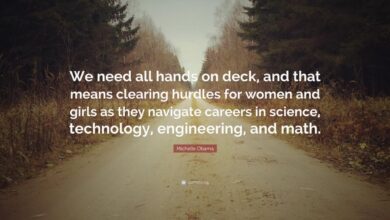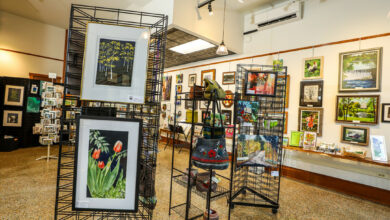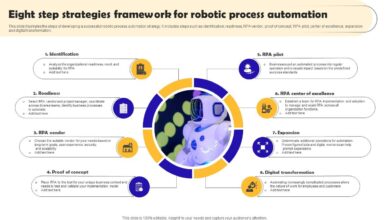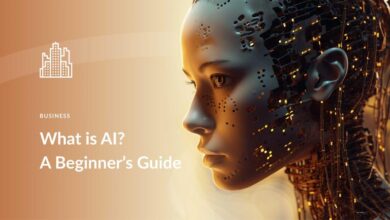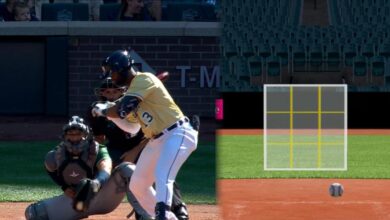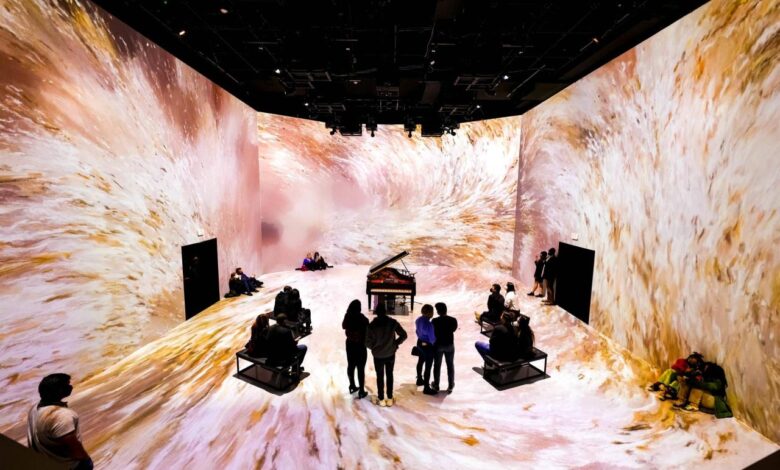
Technology and Creativity Intersect
At the intersection of technology and creativity, a fascinating dance unfolds, where innovation and imagination intertwine. This exploration delves into the evolution of this dynamic relationship, examining how technology has shaped creative expression across various disciplines, and how creativity, in turn, has driven technological advancement.
From the earliest printing presses to today’s AI-powered tools, we’ll trace the historical trajectory of this intersection. We’ll explore how technological advancements have empowered artists, musicians, writers, and designers, fostering new forms of expression and collaboration. Specific examples of how technology is changing the creative process will be analyzed, highlighting both the advantages and potential pitfalls.
Defining the Intersection
The intersection of technology and creativity is a dynamic interplay where innovative tools and techniques are used to express ideas and emotions in new and compelling ways. It’s a constantly evolving landscape, shaping artistic expression and driving technological advancement in parallel. From the earliest forms of artistic expression aided by tools to the sophisticated digital creations of today, this fusion has been a driving force in human progress.This dynamic interaction is not merely a recent phenomenon.
The history of this intersection is rich and multifaceted, marked by periods of innovation and periods of stagnation. Early examples include the printing press, which democratized access to knowledge and literature, enabling a flourishing of creativity across different genres. The invention of photography fundamentally altered how we perceive and document the world, opening up new avenues for visual storytelling and artistic expression.
Historical Evolution
The development of the intersection has been a gradual process, marked by key milestones. Early forms of technology, like the printing press, fundamentally altered the dissemination and accessibility of creative works. The rise of photography in the 19th century revolutionized visual arts, enabling artists to capture reality with unprecedented precision. The 20th century saw the emergence of audio recording and film, dramatically expanding the possibilities for creative expression in music, film, and other mediums.
The digital age, marked by the rise of computers and the internet, has ushered in an era of unprecedented creativity, where individuals can create and share their work globally.
Technology Shaping Creative Expression
Technology has significantly shaped creative expression across various disciplines. In music, digital audio workstations (DAWs) allow musicians to create complex compositions and manipulate sounds in ways previously unimaginable. Visual artists utilize digital tools like Photoshop and 3D modeling software to push the boundaries of artistic expression, enabling intricate detail and experimentation with form and color. Literature benefits from word processors and online publishing platforms, facilitating easier writing, editing, and distribution of literary works.
Creativity Influencing Technology Development
Conversely, creativity has been a driving force behind technological advancements. The need for new tools to express ideas and concepts has spurred innovation in fields like computer graphics, animation, and game design. The desire to create more immersive and engaging experiences has fueled advancements in virtual reality and augmented reality. Artists and designers have often been at the forefront of pushing the boundaries of what’s technologically possible, shaping the very tools that later become mainstream.
Examples of the Intersection
| Technology | Creative Discipline | Impact | Example |
|---|---|---|---|
| Digital Audio Workstations (DAWs) | Music | Increased complexity and manipulation of sounds | Creating layered electronic music tracks, manipulating samples, and synthesizing unique sounds. |
| 3D Modeling Software | Visual Arts | Creation of intricate and detailed digital art | Sculpting realistic figures, creating fantastical environments, and generating unique visual effects. |
| Word Processors and Online Publishing Platforms | Literature | Facilitated easier writing, editing, and distribution | Writing novels, publishing short stories, and creating online literary communities. |
| Virtual Reality (VR) | Gaming, Film, Interactive Arts | Immersive and interactive storytelling and experiences | Creating virtual worlds for gaming, simulating historical events, or developing new forms of interactive narratives. |
Technological Tools and Creative Applications
The intersection of technology and creativity is a vibrant landscape where digital tools are transforming artistic expression and problem-solving across various disciplines. From the intricate designs of 3D models to the nuanced storytelling of interactive narratives, technology empowers creators to push boundaries and explore new avenues of expression. This evolution extends beyond simply automating tasks; it fundamentally alters the creative process itself, opening up possibilities that were previously unimaginable.Technological tools are no longer mere aids but integral components of the creative process.
They offer new perspectives, accelerate workflows, and unlock levels of complexity previously inaccessible. This dynamic interplay of technology and creativity is reshaping industries, fostering innovation, and driving a global exchange of ideas.
Various Technological Tools Empowering Creativity
A plethora of tools now facilitate creativity, from sophisticated software suites to accessible online platforms. These tools span diverse applications, offering a spectrum of functionalities for artists, designers, musicians, writers, and many others. The key lies in understanding the specific tools that align with the unique needs and goals of each creative pursuit.
Examples of Tool Utilization in Creative Practices
D modeling software, for instance, allows architects and designers to visualize complex structures before physical construction, saving time and resources. Similarly, video editing software empowers filmmakers to create dynamic narratives with intricate visual effects. Music production software enables musicians to compose and manipulate sounds with unprecedented precision and control. These are just a few examples of how technology empowers creativity.
Comparison of Technological Tools Across Disciplines
While the fundamental principles of creativity remain consistent, the tools used to express it vary significantly across disciplines. A graphic designer might utilize vector graphics software, while a musician might rely on digital audio workstations (DAWs). The specific tools and techniques employed often reflect the unique demands and characteristics of each discipline. This disparity is a testament to the diverse applications of technology in the creative process.
Creative Software and Platforms Categorized by Function
This categorization provides a framework for understanding the wide range of tools available to creatives. It’s important to remember that many tools can be used across multiple categories, as the lines between them often blur.
- Design Software: This category encompasses tools for creating visual content, including graphic design, web design, and illustration. Examples include Adobe Photoshop, Illustrator, and Figma. These tools are used for everything from logo design to website layouts and detailed illustrations.
- Video Editing Software: Video editing software allows users to manipulate video footage, adding transitions, effects, and audio. Examples include Adobe Premiere Pro, Final Cut Pro, and DaVinci Resolve. These are essential for filmmakers, video editors, and content creators.
- Music Production Software: This category focuses on creating and manipulating audio, including composing, arranging, and mixing music. Examples include Ableton Live, Logic Pro X, and FL Studio. These are fundamental tools for musicians and producers.
- 3D Modeling and Animation Software: These tools are crucial for creating and manipulating 3D models and animations. Examples include Blender, Autodesk Maya, and Cinema 4D. They are utilized by game developers, animators, and architects.
- Writing and Publishing Platforms: These tools facilitate the creation and distribution of written content. Examples include Google Docs, Scrivener, and Medium. These are used by authors, bloggers, and journalists.
Categorized Creative Tools Table
The table below demonstrates a concise overview of various creative tools, their associated disciplines, functions, and illustrative user examples.
| Tool | Discipline | Function | User Example |
|---|---|---|---|
| Adobe Photoshop | Graphic Design | Image editing, manipulation, and creation | A graphic designer creating a logo for a new company. |
| Final Cut Pro | Filmmaking | Video editing, color correction, and post-production | A filmmaker editing a documentary. |
| Ableton Live | Music Production | Music composition, arrangement, and mixing | A musician composing and producing a new song. |
| Blender | 3D Modeling | Creating 3D models, animations, and simulations | A game developer creating 3D characters for a video game. |
| Google Docs | Writing | Document creation, collaboration, and sharing | A student writing a research paper. |
The Impact on Creative Processes
Technology has profoundly reshaped the creative landscape, offering unprecedented tools and possibilities for artists, designers, and innovators. From the initial spark of inspiration to the final product, technology now permeates every stage of the creative process, transforming workflows and fostering new forms of collaboration. This influence extends beyond mere automation, impacting the very nature of creativity itself.The integration of technology into creative processes is not simply about efficiency gains; it’s about unlocking new avenues for exploration, experimentation, and ultimately, the generation of novel ideas.
However, this powerful tool also presents challenges and necessitates a careful consideration of its impact on the creative spirit. Navigating the advantages and disadvantages is crucial to harnessing technology’s potential for creative expression while safeguarding the core values of artistic integrity and originality.
Influence on the Creative Process Itself
Technology influences creative processes by automating repetitive tasks, enabling rapid prototyping, and offering access to a vast repository of information. This allows creators to focus on the more conceptual and imaginative aspects of their work, pushing boundaries and fostering a more iterative approach. For example, software like Adobe Photoshop and Illustrator allows artists to manipulate images and create complex designs with ease, freeing up time for artistic interpretation and exploration of diverse styles.
Advantages of Incorporating Technology
The integration of technology into creative workflows brings several advantages. These include enhanced efficiency, increased access to diverse resources, and the possibility of creating intricate and complex designs. For instance, 3D modeling software enables architects and designers to explore different design iterations quickly and efficiently, facilitating a more iterative design process. The accessibility of online communities and resources allows creators to share ideas, receive feedback, and collaborate with a global network of peers.
Disadvantages of Incorporating Technology
While technology offers significant advantages, it also presents some drawbacks. Over-reliance on technology can sometimes diminish the value of human intuition and instinctual creativity. There’s a risk of losing the unique touch and authenticity that often defines a truly creative work. Furthermore, the pressure to keep up with technological advancements can create stress and anxiety for creators.
Impact on Creative Collaboration
Technology has revolutionized creative collaboration, enabling remote teams to work together seamlessly. Tools like cloud-based platforms and video conferencing facilitate real-time communication and shared access to projects. This has expanded creative collaboration beyond geographical limitations, fostering the creation of diverse and innovative projects. Examples of successful collaborative projects using technology include global design competitions, where teams from different parts of the world can participate and share their unique perspectives.
Technology Facilitating Experimentation and Innovation, At the intersection of technology and creativity
Technology empowers creators to experiment and innovate in ways previously unimaginable. Access to diverse software, tools, and resources allows for rapid prototyping and iteration, encouraging the exploration of new ideas and styles. For example, virtual reality (VR) and augmented reality (AR) technologies provide immersive environments for designers and artists to explore their ideas in novel ways. These technologies enable interactive experiences and unique perspectives that push the boundaries of traditional creative expression.
Analysis of Technology’s Impact on Creative Processes
| Technology | Impact on Process | Advantage | Disadvantage |
|---|---|---|---|
| 3D Modeling Software | Accelerates design iterations, allows for virtual prototyping. | Improved efficiency, reduced costs associated with physical prototypes. | Potential for over-reliance on digital tools, diminishing the importance of hands-on experience. |
| Cloud-based platforms | Enable real-time collaboration among geographically dispersed teams. | Enhanced communication and project management. | Potential for security risks and dependency on stable internet connections. |
| Digital Imaging Software | Streamlines image manipulation, allows for complex designs. | Enhanced precision and flexibility in design. | Risk of losing the value of traditional artistic skills. |
| VR/AR Technologies | Creates immersive experiences for creative exploration. | Unprecedented opportunities for interactive and experiential design. | High cost of equipment, potential for technical limitations. |
Emerging Trends and Future Possibilities: At The Intersection Of Technology And Creativity
The intersection of technology and creativity is rapidly evolving, pushing the boundaries of what’s possible in artistic expression, design, and problem-solving. Emerging technologies are not just tools; they are catalysts for new forms of creativity, offering unprecedented opportunities for innovation. This dynamic interplay between human ingenuity and technological advancement promises a future where creative endeavors are amplified and reshaped in unforeseen ways.
Emerging Trends in Technology-Creativity
The landscape of creative technology is constantly shifting, with new trends emerging regularly. AI-powered tools are becoming increasingly sophisticated, enabling artists and designers to explore novel possibilities. The fusion of virtual and augmented realities is creating immersive experiences, transforming how we interact with art and design. Furthermore, the rise of decentralized platforms and blockchain technology is creating new avenues for creative ownership and distribution.
These advancements are not merely incremental improvements but rather foundational shifts in how we approach creativity itself.
Potential Future Directions
Future directions in the intersection of technology and creativity will likely involve the increasing integration of AI in creative processes. This integration will not replace human creativity but will empower it by automating mundane tasks and augmenting human capabilities. Furthermore, the convergence of virtual and augmented realities will provide immersive environments for artistic expression, enabling users to interact with and shape virtual spaces.
This will lead to novel forms of interactive art and design. Ultimately, the future will see technology as a powerful tool for collaboration and experimentation within the creative process.
Technological Advancements Reshaping Creative Practices
Technological advancements are reshaping creative practices in numerous ways. For example, AI-powered tools are being used to generate novel ideas, compose music, and create artwork, opening up new avenues for experimentation and innovation. Furthermore, 3D printing and other digital fabrication techniques are allowing artists and designers to bring their creations to life with unprecedented precision and control. The development of interactive digital environments is providing new platforms for creative expression, facilitating the creation of immersive and dynamic experiences.
Emerging Technologies Fostering New Forms of Creativity
Several emerging technologies hold the potential to foster entirely new forms of creativity. These include: advanced AI models, the metaverse, virtual reality and augmented reality, and decentralized creative platforms. These technologies are poised to revolutionize the creative process, offering artists and designers tools for experimentation, collaboration, and the creation of unprecedented artistic forms.
Exploring the intersection of technology and creativity is fascinating, isn’t it? It’s like finding the perfect blend of innovation and imagination. A great example of this interplay is the concept of “Hello world!”, a fundamental programming exercise that often marks the beginning of a coder’s journey. Hello world! demonstrates how simple code can create a profound connection between the digital realm and human expression.
Ultimately, this intersection of technology and creativity fuels progress in countless ways.
Emerging Technologies and Their Impact
| Emerging Technology | Potential Impact | Example Application | Challenges |
|---|---|---|---|
| Advanced AI models | Automating repetitive tasks, generating novel ideas, enhancing creative processes. | AI-powered music composition software, AI-generated art pieces, assisting in design iterations. | Ensuring ethical use, maintaining human control over creative output, addressing potential bias in algorithms. |
| Metaverse | Creating immersive and interactive environments for creative expression. | Virtual exhibitions, interactive installations, collaborative virtual spaces for artists. | Addressing accessibility concerns, managing potential issues with digital ownership and intellectual property. |
| Virtual Reality (VR) and Augmented Reality (AR) | Providing new mediums for creative expression and interactive experiences. | Immersive storytelling, interactive installations, designing virtual environments for architectural visualization. | Cost of hardware and software, maintaining high-quality VR/AR experiences, user comfort and potential motion sickness. |
| Decentralized Creative Platforms | Empowering creators with greater control over their work and distribution. | Crypto-art platforms, decentralized marketplaces for digital assets, blockchain-based copyright systems. | Ensuring security and trust on these platforms, educating creators about new technologies, integrating new technologies with existing workflows. |
Ethical Considerations and Societal Implications
The convergence of technology and creativity, while brimming with potential, also raises complex ethical questions. As AI tools become more sophisticated in generating art, music, and writing, the lines between human creation and machine output blur, prompting critical reflection on authorship, originality, and intellectual property. These advancements also have significant societal implications, demanding careful consideration of their impact on employment, accessibility, and cultural expression.The ethical landscape surrounding this intersection is constantly evolving, requiring a proactive and adaptable approach to responsible innovation.
We must acknowledge the potential for misuse and develop frameworks that promote fairness, inclusivity, and equitable access to the benefits of technological advancement in creative fields. This includes considering the impact on existing artists, the potential for algorithmic bias, and the safeguarding of user data in creative applications.
Ethical Dilemmas in Creative Technological Advancements
Technological advancements in creative fields have given rise to several ethical dilemmas. The ability of AI to generate art, music, and writing raises concerns about originality and authorship. Who owns the intellectual property created by AI? Is it the programmer, the AI itself, or the user who interacts with the AI? This uncertainty complicates copyright laws and the very definition of artistic expression.Another key concern involves the potential for bias in AI-generated content.
If the training data reflects societal prejudices, the output may perpetuate and amplify those biases. This issue is particularly pertinent in areas like image generation and text-based creative applications, as the AI can learn and reflect the biases present in the training data. For example, an AI trained on a dataset predominantly featuring white male artists may disproportionately produce artwork in that style, potentially excluding other voices and perspectives.
Societal Implications of Technological Creativity
The intersection of technology and creativity has far-reaching societal implications. The automation of creative tasks through AI raises concerns about job displacement, particularly in fields like graphic design, music composition, and even writing. How will artists adapt to a world where some aspects of their work can be readily replicated or augmented by technology? This transformation necessitates proactive measures to support artists in retraining and adaptation.Additionally, the accessibility of creative tools through technology can potentially democratize artistic expression.
AI-powered tools can empower individuals with limited resources or access to specialized training to engage in creative activities. However, the digital divide and the potential for unequal access to these tools could exacerbate existing inequalities, creating a further divide between those who can afford and utilize these technologies and those who cannot.
Responsible Innovation in Creative Technology
Responsible innovation is crucial in navigating the ethical and societal implications of technology in creative fields. This requires a multi-faceted approach encompassing collaboration among artists, technologists, ethicists, and policymakers. By establishing clear guidelines and frameworks for the development and deployment of creative technologies, we can mitigate potential risks and ensure that these advancements benefit society as a whole.
This includes a focus on fairness, transparency, and inclusivity in the design and use of AI tools.
“Responsible innovation is not just about mitigating harm, but also about maximizing benefits, ensuring that technological advancements serve the common good.”
Table: Ethical Considerations in Creative Technology
| Technology | Ethical Concerns | Societal Impact | Potential Solutions |
|---|---|---|---|
| AI Art Generation | Authorship, originality, intellectual property; potential for bias in training data; displacement of human artists | Changes in artistic profession, impact on cultural expression, exacerbating digital divide | Clear copyright frameworks; diverse and representative training datasets; retraining and reskilling programs for artists; ethical guidelines for AI use in art |
| AI Music Composition | Copyright, originality of musical styles; potential for perpetuating existing musical trends; impact on musicians | Changes in the music industry, impact on musical diversity, potential for job displacement in the music sector | Clearer copyright policies; diverse and representative training datasets; development of tools to foster musical creativity; support for musicians in adaptation |
| AI Writing Assistance | Authorship, plagiarism concerns; potential for biased or harmful content; impacts on writers | Impact on writing professions, impact on quality and diversity of written content, potential for misuse | Clear guidelines for use in academic and professional contexts; tools to identify AI-generated content; promoting ethical use of AI writing tools |
Creative Industries and Technological Adaptation
The creative industries are experiencing a period of rapid transformation driven by technological advancements. From music production to film editing, digital tools are reshaping how artists and professionals work, impacting workflow, accessibility, and the very nature of artistic expression. This adaptation isn’t always straightforward, and understanding the challenges and successful strategies is crucial for navigating this evolving landscape.
Adapting to Technological Advancements
Various creative industries are actively adapting to new technologies. The adoption ranges from embracing readily available software to developing entirely new platforms and workflows. This adaptability allows creatives to explore novel approaches to their craft, reach broader audiences, and improve efficiency in production and distribution.
Examples of Successful Adaptations
Numerous creative professionals have successfully integrated technology into their practices. Music producers are utilizing digital audio workstations (DAWs) to create complex and layered soundscapes. Film editors leverage sophisticated software to manipulate footage, enhance visual effects, and achieve innovative editing styles. Graphic designers utilize vector graphics software to create high-resolution visuals for various platforms. These examples showcase the creative potential unleashed by technological integration.
Challenges in Embracing New Technologies
Despite the opportunities, creative industries face hurdles in adopting new technologies. The initial investment in equipment or software can be significant, and retraining existing personnel on new tools and techniques is a crucial but often challenging aspect of adaptation. Furthermore, maintaining quality control and adhering to creative vision in the face of technology’s often overwhelming capabilities can be demanding.
Keeping pace with rapid technological advancement and the associated learning curve presents a continuous challenge.
The Role of Education and Training
Education and training play a critical role in fostering adaptation to technological changes. Creative programs must evolve to equip students with the necessary digital skills and provide a comprehensive understanding of how technology intersects with artistic practice. Workshops, online courses, and mentorship programs can provide crucial support to professionals looking to enhance their technological proficiency. Furthermore, a focus on critical thinking and creative problem-solving skills is essential to help professionals navigate the evolving technological landscape.
Strategies for Technological Integration
Successfully integrating technology requires a strategic approach. A well-defined plan, incorporating phased implementation, clear training programs, and ongoing support, is essential. Prioritizing the learning curve for new tools and encouraging experimentation while maintaining creative vision are vital.
Industry-Specific Adaptations
| Industry | Technological Adaptation | Challenges | Strategies |
|---|---|---|---|
| Film | Digital cinematography, 3D modeling, VFX software, online distribution platforms | High initial investment in equipment, training personnel on new software, maintaining artistic vision amidst technology’s capabilities. | Phased adoption of technology, comprehensive training programs, fostering collaboration between artists and technologists. |
| Music | Digital audio workstations (DAWs), online music distribution platforms, virtual concerts | Maintaining the unique sound of an instrument in a digital environment, adapting to changing consumer behavior, ensuring creative control amidst the digital landscape. | Developing innovative digital tools for musicians, offering training programs for digital audio workstations, collaborating with online music distribution platforms. |
| Graphic Design | Vector graphics software, digital illustration tools, online design platforms | Maintaining the quality and aesthetic of designs in digital formats, adapting to changing design trends, keeping up with new design software and platforms. | Encouraging experimentation with digital tools, providing access to high-quality design software, organizing workshops for exploring new tools. |
Illustrative Examples of Technology and Creativity
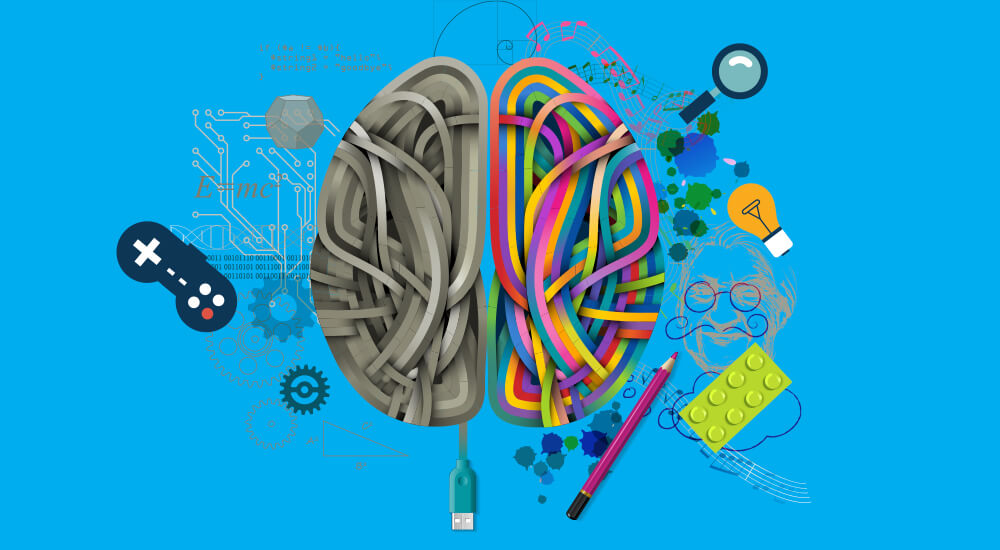
The intersection of technology and creativity is vibrant and dynamic, producing innovative works across various disciplines. From interactive installations to algorithmic art, these examples showcase how technological tools are reshaping creative processes and expanding artistic possibilities. This exploration delves into specific examples, examining the creative process, the role of technology, and the key factors that contribute to their success.
Interactive Installations: A Fusion of Technology and Experience
Interactive installations offer a unique experience for viewers, blurring the lines between art and technology. These immersive environments often employ sensors, projections, and other digital tools to respond to audience input. The success of these installations often hinges on the seamless integration of the technological elements with the artistic vision.
- The “Kinetic City” installation: This installation utilizes sensors embedded in the floor and walls to respond to the movement of visitors. As people walk through the space, light patterns shift, sounds change, and projections dynamically respond to their actions. The creative process involved designing the algorithms that govern the interaction between the physical space and the digital components. This required meticulous planning and testing to ensure the installation flowed smoothly.
Key to its success was the seamless integration of the physical space and the digital components, allowing visitors to feel a dynamic interaction.
Algorithmic Art: Exploring the Creative Potential of Computation
Algorithmic art is a fascinating area where computers are used as tools to generate art. The technology, in this case, isn’t simply a medium, but a collaborator in the creative process. Algorithms can be programmed to generate images, music, or even poetry, pushing the boundaries of what’s considered art. Success in this field hinges on the careful crafting of the algorithm and the artistic interpretation of the output.
- Generative Adversarial Networks (GANs) in painting: GANs are machine learning models composed of two neural networks, a generator, and a discriminator. The generator creates images, and the discriminator evaluates their authenticity. Through an iterative process, the generator learns to produce images that fool the discriminator. In the context of painting, GANs can be trained on vast datasets of existing artwork to generate new styles or interpretations.
The creative process involved defining the training data, choosing the appropriate architecture, and iterating on the algorithm’s parameters to achieve desired results. Success relies on finding the right balance between algorithm control and allowing the network to generate novel results.
Music Composition with AI: Exploring Collaboration
The use of technology in music composition has evolved significantly, moving from simple tools to sophisticated AI systems. AI can assist composers in generating melodies, harmonies, and even entire compositions, opening up new avenues for musical exploration. The success of this approach relies on the interaction between human creativity and the technological tools.
- AI-generated musical scores for film: AI systems can analyze existing film scores and generate new music that complements a given scene or emotional arc. This process involves inputting the desired mood, tempo, and instrumentation to train the AI model. The success of this method hinges on the ability of the AI to generate music that is both original and evocative, fitting the specific context of the film.
Last Recap
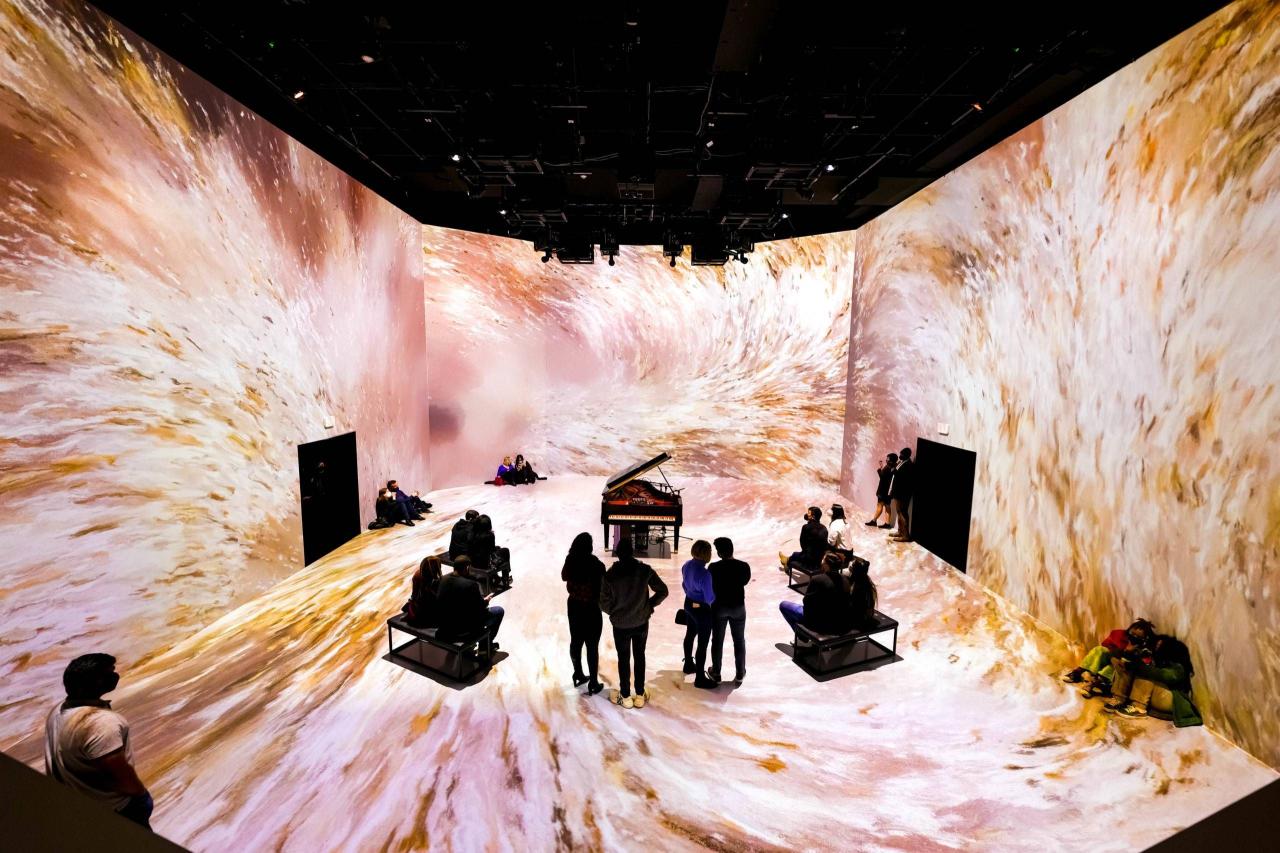
In conclusion, the intersection of technology and creativity is a dynamic and ever-evolving landscape. While technology provides unprecedented tools and opportunities, it’s crucial to consider the ethical implications and societal impacts. The future promises even more exciting possibilities as technology continues to shape the creative process. By understanding the past, embracing the present, and anticipating the future, we can navigate this exciting frontier responsibly and creatively.

